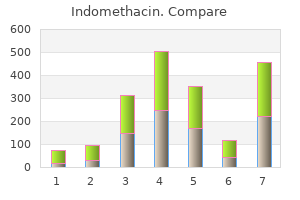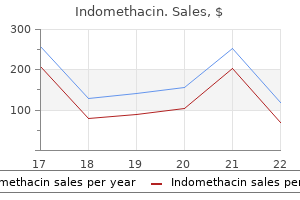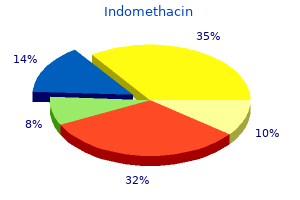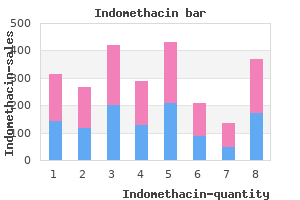





|
STUDENT DIGITAL NEWSLETTER ALAGAPPA INSTITUTIONS |

|
"Discount indomethacin 50mg line, rheumatoid arthritis in dogs feet".
G. Marus, M.S., Ph.D.
Associate Professor, Morehouse School of Medicine
Significant hemolysis is rarely associated with modern valves when they are normally functioning rheumatoid arthritis in the knee symptoms buy indomethacin 75mg visa. Patients with multiple mechanical valves or an older valve with a caged ball design are more likely to have hemolysis arthritis in back home remedies buy indomethacin 75 mg on-line. Significant hemolysis is more often seen with paravalvular leaks caused by partial valve ring dehiscence or infection rheumatoid arthritis nausea discount indomethacin 25 mg on line. When a paravalvular leak develops arthritis suitable diet effective 50mg indomethacin, blood flows at high shear rates through a small orifice. Patches placed to close septal wall defects may be the source of hemolysis if they do not support endothelial growth and if flow is turbulent in the area of the patch. Fragmentation has also been observed in patients with artificial hearts, left ventricular assist devices, vascular grafts, traumatic arterial venous fistulas, dialysis catheters, and transjugular portosystemic shunts. Typically, hemolysis associated with cardiac valves, large vessels, or prosthetic devices does not cause thrombocytopenia. Constant intravascular hemolysis and hemoglobinuria will eventually result in iron deficiency. Patients with significant valve hemolysis do better if iron deficiency is corrected and folate is supplemented. Therefore, decreasing cardiac output by correction of anemia with blood transfusions, avoidance of strenuous exercise, and judicious use of afterload reduction or beta-blockers may be of benefit. Patients with severe paravalvular leakage may eventually require replacement of the valve. A little-known consequence of exertion is a mild hemolytic process marked by decreased serum haptoglobin and hemoglobinuria in distance runners, marathon enthusiasts, and triathletes. Destruction of red cells occurs because of repetitive foot strike-induced damage in the small vessels of the feet as they meet hard pavement. March hemoglobinuria was described in soldiers fitted with heavy boots with no cushioning for the feet. The advent of shoes with extensive supportive cushions has reduced the occurrence of foot strike hemolysis. Reticulocytosis is rarely observed, and other tests for hemolysis are typically uninformative. Lesser degrees of red cell destruction occur with the less traumatic exertion associated with aerobic exercises, rowing, weight lifting, and even swimming. Hemoglobinuria as a result of destruction of erythrocytes by hand trauma also occurs after long sessions playing the conga drum and after enthusiastic karate practices. Hemolysis may be caused by the direct physical trauma to red cells or because the red cells are damaged as they come into contact with damaged endothelium. In occasional patients with known hereditary hemolytic disorders, hemoglobinuria develops with exercise. The contribution of exertional hemolysis to the mild anemia observed in well-conditioned athletes is uncertain. The plasma volume is expanded as a result of conditioning, and there is evidence of gastrointestinal blood loss following distance running events. The frequent use of non-steroidal anti-inflammatory agents by competitive athletes may also result in gastritis and iron deficiency. Early reports of exertional hemolysis implicated hemoglobinuria as a factor contributing to iron deficiency in athletes. Muscle destruction and myoglobinuria must also be considered in an athlete who overexerts. Better shoes, shorter distances, slower pacing, and running on grass and cinder paths instead of pavement will reduce foot strike hemolysis. Intravascular hemolytic anemia and renal failure have been described after intentional ingestion of copper sulfate in suicide attempts and recently in two men after drinking a ceremonial Nigerian "spiritual water. One component of copper toxicity is oxidant damage to the red cell as evidenced by the appearance of Heinz bodies and the greater degree of toxicity for patients who are glucose-6-phosphate dehydrogenase deficient. Osmotic lysis of red cells has been reported after near-drowning in fresh water and after exposure of patients to hypotonic fluid during dialysis. Distilled water instilled during prostate surgery has also been associated with osmotic swelling of red cells and hemolysis. Thermal injury also damages red cells; a brisk intravascular hemolysis accompanied by spherocytosis and unusual red cells with membrane extensions or blebs develops in patients with extensive burns. In vitro studies show that the principal membrane protein, spectrin, is unstable and unfolds when heated to 49° C.

During pregnancy arthritis in fingers what does it feel like cheap indomethacin 50 mg otc, especially in the third trimester arthritis pain keeps me up at night buy 75mg indomethacin with visa, thyroxine replacement needs increase by 30 to 50% hip arthritis definition order indomethacin 50mg online. The ease of approach arthritis relief without nsaids cheap 25 mg indomethacin mastercard, virtual absence of side effects, and observance of a revitalized patient make thyroxine treatment of hypothyroid patients a satisfying therapeutic experience. Clinical improvement begins 2 to 3 weeks after therapy, but complete resumption of a euthyroid state can take several months. Chronic overreplacement with thyroxine can increase bone turnover, which is a special concern in women; however, no evidence currently exists for an increased bone fracture rate. Chronic T4 overreplacement also can lead to cardiovascular abnormalities, especially arrhythmias and cardiac hypertrophy. In addition to thyroxine, triiodothyronine T3, combinations of T4 and T3, desiccated thyroid, and thyroxine plus iodine in one tablet are available. In patients with the rare condition of 5 deiodinase deficiency T3 preparations are also useful. Other thyroid preparations have no advantage over thyroxine and are not recommended. The complaint of angina pectoris most often arises with thyroid hormone replacement, which increases cardiac demand and O2 consumption. Adequate thyroid hormone replacement is strongly recommended in these patients because in addition to the general benefit of a euthyroid state, cholesterol levels may decrease and blood pressure may normalize. Frequently, worsening of the angina precludes adequate thyroid hormone replacement. Treatment with beta-sympathetic blockers such as propranolol (20 to 40 mg three times a day) can sometimes ameliorate the problem but may lead to significant bradycardia. Also, beta-blockade fails to solve the basic dilemma between inadequate thyroid hormone replacement and angina production. In such patients with persistent mild to moderate hypothyroidism, percutaneous coronary transluminal angioplasty or coronary bypass surgery can be undertaken. Several studies have shown no deleterious consequences of a mild to moderate hypothyroid state on clinical outcome. Patients with severe myxedema, either spontaneously or suffering from cold exposure, intake of analgesics or sedatives, or infection, may become progressively obtunded and lapse into coma. Assessment of adrenal function should also be undertaken because giving hydrocortisone can disturb pituitary-adrenal feedback and make subsequent diagnosis difficult. Thyroxine can be given as a single 300 mug T4 bolus followed by daily 50- to 100-mug intravenous T4 maintenance doses. A T3 replacement schedule using 10 mug T3 intravenously every 4 hours until the patient greatly improves and oral therapy can be resumed has been advocated. T3 administration offers the potential advantage that no conversion of T4 to T3 is required, a step that may be impaired in severely ill patients. Postpartum thyroiditis is classified as a variant of subacute painless lymphocytic thyroiditis. Acute (Suppurative) Thyroiditis Acute suppurative thyroiditis consists of a rare infection of the gland by bacteria, fungi, Pneumocystis carinii, or other organisms. Symptoms include tender swelling, sometimes with fluctuation and an erythematous skin overlying the area. Identification of the microbial agent may require fine-needle aspiration of the lesion. Long-term sequelae are rare, but when a large part of the thyroid gland is involved, hypothyroidism may occur. Subacute painful thyroiditis is not rare, resulting in 5% of all medical consultations for thyroid disease. The disease frequently follows a viral infection, and elevated titers to mumps, adeno-, entro-, echo-, influenza, coxsackie-, measles and other viruses have been found. Such antibodies are polyclonal and most likely 1245 arise secondary to thyroid damage caused by viral infection. The thyroid is enlarged and edematous with destruction of follicular architecture and the presence of histocytes that coalesce into giant cells. The disease frequently follows by 1 to 3 weeks the occurrence of viral pharyngitis, mumps, measles, or other viral syndromes. Severe pain develops over the thyroid area, radiates to the ear, and is enhanced by swallowing. A feeling of general malaise with muscle aches, pain, anorexia, and fever is present.

Adenocarcinomas account for about half of the malignant tumors of the small intestine arthritis neck dizzy spells generic 75mg indomethacin otc, with a peak incidence in the sixth and seventh decades arthritis pain symptoms foot discount indomethacin 75mg without a prescription. When postbulbar in location rheumatoid arthritis vagus nerve stimulation 75mg indomethacin visa, adenocarcinoma may simulate peptic ulcer disease; when in the periampullary region arthritis relief for backs 25mg indomethacin overnight delivery, it may cause obstructive jaundice. More distally, adenocarcinomas may remain silent until symptoms of intestinal obstruction or gastrointestinal hemorrhage occur. Carcinoids are the most frequently occurring small intestinal neoplasm, with more than half found incidentally either at autopsy or at operation for other diseases. Small carcinoid tumors may be asymptomatic, but larger carcinoid tumors can obstruct the lumen or bleed (Color Plate 3 D). Once metastasis occurs to the liver, features of the carcinoid syndrome become apparent (see Chapter 245). Weight loss, intestinal obstruction, fever, bleeding, and evidence of malabsorption syndrome are features of lymphoma. Massive hemorrhage and intestinal perforation may be the presenting symptoms of large sarcomas. Physical examination may be unremarkable in patients with benign tumors, unless the neoplasm is large enough to present with a mass. Loud borborygmi, visible peristalsis, and abdominal distention may be present in intestinal obstruction. In patients with malignant small bowel neoplasms, more obvious physical findings may be evident. Peripheral lymphadenopathy or splenomegaly may be found in those with extensive lymphoma. Obstructive jaundice may occur with periampullary neoplasms, bile duct cancer, impacted common duct stones, pancreatitis, and pancreatic cancer (see Chapter 140). Intestinal obstruction may be due to adhesions, particularly in patients who have had prior abdominal operations, internal hernias, volvulus, or intussusception. Elevation of alkaline phosphatase and bilirubin levels may occur if the ampulla of Vater is obstructed or if liver metastases are present. Elevated levels of plasma serotonin or urinary 5-hydroxyindoleacetic acid occur in the carcinoid syndrome (see Chapter 245). Dysproteinemia is a typical feature of Mediterranean lymphoma and is characterized by the presence of abnormal fragments of immunoglobulin A (Ig) A in the serum and urine that is devoid of light chains (see Chapter 179). Upper gastrointestinal tract barium radiographs and selective nasoenteric intubation (enteroclysis), which permits the introduction of barium and air into a relatively localized segment, may be useful in localizing tumors. Intestinal lymphoma may occasionally be diagnosed by peroral intestinal biopsy, but the disease mainly involves the lamina propria and usually requires a full-thickness surgical biopsy. A thorough staging of lymphoma involves bone marrow biopsy, laparotomy with splenectomy, and biopsies of regional lymph nodes and liver. Front-viewing and side-viewing fiberoptic endoscopes are used to examine the duodenum; suspicious lesions can be biopsied and brushed. Endoscopic ultrasound may be helpful in defining depth of involvement of a specific lesion. Periampullary lesions can be well visualized; the pancreatic and biliary trees can be studied by contrast radiography after endoscopic cannulation. Small bowel enteroscopy is sometimes helpful in localizing a small bleeding lesion. Treatment is primarily surgical for symptomatic benign tumors, adenocarcinomas, leiomyosarcomas, malignant carcinoids, and those with secondary involvement of the small intestine. The prognosis for benign tumors of the intestine is good if surgical resection can alleviate bleeding and obstruction. The prognosis for leiomyosarcomas and primary lymphomas is good if surgical resection is complete, but this is rarely possible. Patients with malignant carcinoid tumors may survive for long periods, even in the presence of extensive hepatic involvement. Primary small intestinal lymphomas occurring in populations in the Middle East could possibly be decreased by public health measures that decrease parasitic infestation. Earlier diagnosis and adequate 750 treatment of celiac disease (gluten-free diet) may reduce the frequency of malignancy. In patients with familial polyposis syndromes, duodenal and periampullary adenomas should be monitored periodically.

Therefore remedies for arthritis pain in joints generic indomethacin 75 mg on line, marked increases in the number of red blood cells per cubic milliliter of blood produce elevations in blood viscosity that can cause pulmonary hypertension arthritis underarm pain order indomethacin 50mg without prescription. Another factor that can increase pulmonary arterial pressure is elevation in intrathoracic pressure enteropathic arthritis definition purchase indomethacin 75mg mastercard, which is directly transmitted to the pulmonary vasculature arthritis in back of leg generic 75mg indomethacin visa. Dysfunctional pulmonary vascular endothelium plays an important role in the pathophysiology of pulmonary hypertension. Normal endothelium releases growth factors and cytokines that regulate vascular smooth muscle tone, proliferation, and migration. Dysfunctional endothelium leads to vasoconstriction and intravascular thrombus formation. A variety of pulmonary vascular endothelial abnormalities have been demonstrated in patients with pulmonary hypertension, including impaired endothelium-dependent vasodilatation, decreased elaboration of vasodilating nitric oxide and prostacyclin, elevated circulating levels of the potent vasoconstrictor endothelin, and increased levels of various clotting factors such as fibrinopeptide A, Factor Vlllc, von Willebrand factor, and plasminogen activator inhibitor. Pulmonary hypertension can be divided into three classes based on the location of the abnormal increase in pulmonary vascular resistance: precapillary, passive, and reactive. Patients with increased pulmonary arteriolar and/or arterial resistance are classified as having precapillary pulmonary hypertension. Pulmonary arterial pressure is increased, but pulmonary capillary wedge and pulmonary venous pressures are normal. Examples include hypoxic pulmonary hypertension (increased arteriolar resistance) and pulmonary embolism (increased arterial resistance) (see Chapter 84). Individuals with increased pulmonary venous pressure secondarily causing pulmonary arterial hypertension are said to exhibit passive pulmonary hypertension because the increase in pulmonary arterial pressure occurs passively-without active pulmonary arterial vasoconstriction. The gradient between the mean pulmonary arterial pressure and the pulmonary capillary or pulmonary venous pressures is less than or equal to 12 mm Hg. The third form of pulmonary arterial hypertension is termed reactive and contains elements of both precapillary and passive pulmonary hypertension. Reactive pulmonary hypertensive patients have elevated pulmonary venous pressure as well as pulmonary arteriolar vasoconstriction. The gradient between the mean pulmonary arterial pressure and the pulmonary capillary or pulmonary venous pressures is greater than 12 mm Hg. Patients with reactive pulmonary arterial hypertension usually have long-standing mitral stenosis. Increased resistance to blood flow through the pulmonary arterial circulation can be the result of large pulmonary emboli or loss of pulmonary arterial cross-sectional area from various disease entities. Increased pulmonary arteriolar resistance is commonly the result of hypoxia and/or acidosis, which cause pulmonary arteriolar vasoconstriction. Patients with congenital heart disease with left-to-right shunts can develop markedly increased pulmonary arteriolar vascular resistance through a pathophysiologic process that begins as vasoconstriction and ends with obliteration and loss of pulmonary microvessels. Primary pulmonary hypertension is the result of abnormal increases in pulmonary arteriolar tone. The resultant pulmonary hypertension in these patients leads to thickening of the intimal and medial layers of the pulmonary arterioles, which, in turn, further 275 exacerbates the degree of pulmonary hypertension. A vicious spiral is thereby engendered in which ever-increasing levels of pulmonary arterial hypertension lead to further arteriolar thickening, which leads to worsening pulmonary hypertension. This pathophysiologic sequence is also seen in patients with congenital heart disease who develop pulmonary vascular disease and pulmonary hypertension. Increased pulmonary venous pressure and vascular resistance are other causes of pulmonary hypertension: increased pulmonary venous pressure leads to augmented pulmonary capillary and pulmonary arterial diastolic pressure. Pulmonary arterial systolic and mean pressure must increase in this setting to maintain forward cardiac output. Disease entities that increase pulmonary venous pressure and resistance to blood flow include pulmonary venous thrombosis. Individuals with more severe pulmonary hypertension usually complain of dyspnea on exertion secondary to exercise-induced decreases in cardiac output and increases in pulmonary arterial pressure. Other symptoms can include easy fatigability, exertional chest discomfort and/or syncope, cough, hemoptysis, and, rarely, hoarseness secondary to compression of the left recurrent laryngeal nerve by a dilated left pulmonary artery. Doppler studies predict with considerable accuracy the level of pulmonary arterial systolic and mean pressures.

Paradoxical splitting of S2 may reflect left bundle branch block or prolongation of the pre-ejection period with delayed aortic valve closure despite decreased stroke volume arthritis treatment by yoga 75mg indomethacin overnight delivery. A mitral regurgitation murmur indicative of either papillary muscle dysfunction or rupture or annulus dilatation may be audible even if cardiac output is diminished markedly arthritis medication starting with t generic indomethacin 75 mg without prescription. A systolic murmur and thrill indicative of ventricular septal rupture may be heard arthritis pain treatment for hands order indomethacin 50 mg without prescription, and a pericardial friction rub may be evident arthritis rash generic indomethacin 75mg fast delivery. Premature ventricular beats, brief runs of ventricular tachycardia, or accelerated idioventricular rhythm are common. Peripheral cyanosis, edema, and pallor may indicate vasoconstriction, and diminished cardiac output may reflect right ventricular dysfunction or failure. Recrudescence of signs or symptoms of a previously sustained cerebrovascular accident may occur secondary to diminished cerebral perfusion. Laboratory evaluation is particularly helpful in the presence of co-morbid conditions that may affect prognosis and influence care, such as diabetes, renal or hepatic failure, anemia, bleeding disorders, and respiratory failure. The complete blood count and platelet count (which often decreases after heparin is given) are useful not only diagnostically but also in assessing suitability for treatment with thrombolytic drugs. The leukocyte count may be normal initially, but it generally increases within 2 hours and peaks in 2 to 4 days, with predominance of polymorphonuclear leukocytes and a shift to the left. The chest radiograph is useful in determining the presence or absence of cardiomegaly, pulmonary edema, pleural effusions, Kerley B lines, and other criteria of heart failure. A small cardiac silhouette and clear lung fields in a patient with systemic hypotension may indicate relative or absolute hypovolemia. Chest radiographic findings indicative of pulmonary venous hypertension may occur later and persist longer because of delay in fluid shifts among vascular, interstitial, and alveolar spaces. These macromolecules are abundant in myocardium and are virtually absent from most other tissues. Elevated troponin levels, either assayed quantitatively in the regular laboratory or semiquantitatively with hand-held devices in the emergency department, can also help predict which patients with clinical unstable angina (see Chapter 59) will subsequently develop serious complications. False-positive troponin T but not troponin I elevations occur in patients with renal insufficiency. The preferred non-invasive modality to evaluate regional wall motion and overall ventricular performance is usually color-flow Doppler transthoracic echocardiography. In patients with ventricular thrombi, treatment entails administration of fibrinolytic drugs, anticoagulants, or both. Imaging is useful also to detect pericardial effusion, concomitant valvular or congenital heart disease, and marked depression of ventricular function that may interdict treatment in the acute phase with beta-adrenergic blockers. Echocardiography is also helpful in delineating recovery of stunned or hibernating myocardium. Doppler echocardiography is particularly useful to estimate the severity of mitral or tricuspid regurgitation, detect ventricular septal defects secondary to rupture, assess diastolic function, monitor cardiac output calculated from flow velocity and aortic outflow tract area estimates, and estimate pulmonary artery systolic pressure. Positron-emission tomography with tracers of intermediary metabolism, perfusion, or oxidative metabolism permits quantitative assessment of the distribution and extent of impairment of myocardial oxidative metabolism and regional myocardial perfusion (see Chapter 44). It can also define the efficacy of therapeutic interventions designed to salvage myocardium and has been used diagnostically to differentiate reversible from irreversible injury in hypoperfused zones. In the initial evaluation, definitive diagnosis often cannot be made immediately, and it is less important than appropriate assessment. If patients do not show evidence of myocardial necrosis, recurrent ischemia, hemodynamic abnormalities, or arrhythmias, they are suitable for risk stratification with exercise stress testing or stress echocardiography or scintigraphy before being discharged (see below). Unstable known coronary disease (in terms of frequency, duration, intensity, or failure to respond to usual measures) b. Major new arrhythmias (new-onset atrial fibrillation, atrial flutter, sustained supraventricular tachycardia, second-degree or complete heart block, or sustained or recurrent ventricular arrythmias) d. Major arrhythmias (new-onset atrial fibrillation, atrial flutter, sustained supraventricular tachycardia, second-degree or complete heart block, or sustained or recurrent ventricular arrhythmias) 2. Community-based systems in Belfast, Ireland; Columbus, Ohio; Los Angeles; and Seattle have documented conclusively the effectiveness of rapid response by rescuers.